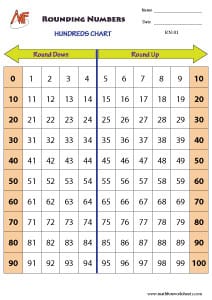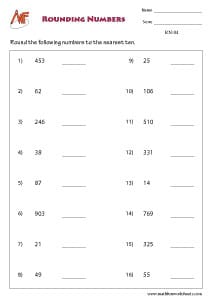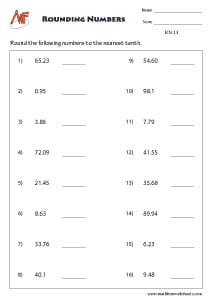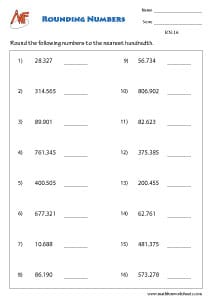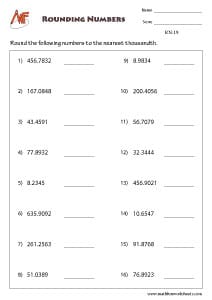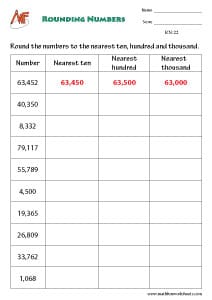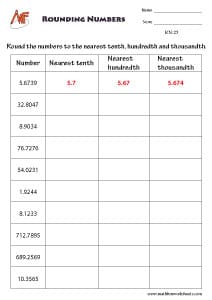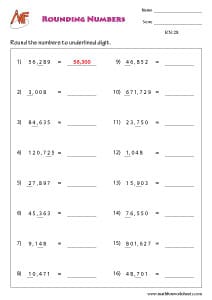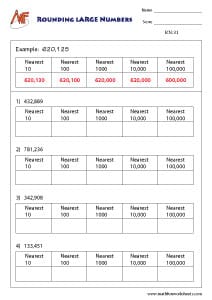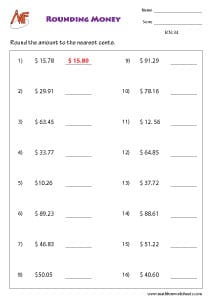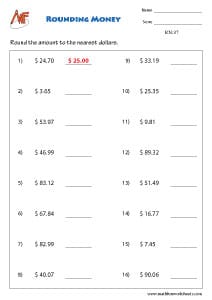- Home
- Numbers & Operations
- Rounding Numbers
Browse by Topics
- English Worksheets
- Science Worksheets
- Kid's Corner
- Numbers & Operations
- Addition
- Subtraction
- Multiplication
- Division
- Decimals
- Place Value
- Roman Numerals
- Skip Counting
- Odd & Even Numbers
- Patterns
- Cardinal & Ordinal Numbers
- Rounding Numbers
- Estimation of Numbers
- Estimation of Time & Money
- Counting & Cardinality
- Comparing Numbers
- Ordering Numbers
- Fractions
- Prime & Composite Numbers
- Squares & Cubes
- Square & Cube Root
- Divisibility Rules
- Factors & Multiples
- Data Handling
- Algebra
- Ratio
- Least Common Factor
- Greatest Common Factor
- Percent Worksheets
- Proportion
- Order of Operations
- Scientific Notation
- Exponents
- Algebraic Expressions
- Evaluating Algebraic Expressions
- Simplifying Algebraic Expressions
- Graphing Lines
- Point Slope Form
- Two Point Form
- Two Intercept Form
- Equations
- Identifying Functions
- Evaluating Functions
- Function Table
- Domain and Range
- Trigonometric Charts
- Quadrants
- Polynomials
- Measurement
- Geometry
- Word Problems
Rounding Numbers worksheets
Understanding rounding numbers is an important math skill that helps students estimate and work with simpler values. Whether you’re rounding to the nearest ten, hundred, or even decimal places, this concept makes numbers easier to use in everyday situations like shopping, measuring, or budgeting. It’s a foundational skill that supports mental math and problem-solving.
To begin, explain the basic rule: if the digit after your rounding place is 5 or more, round up; if it’s 4 or less, round down. This simple guideline applies whether you’re rounding whole numbers or decimals. For example, rounding 47 to the nearest ten gives you 50, while rounding 43 gives you 40.
1. We always round up numbers to make figures easy.
Eg. 10/3 = 3.3333. Round the numbers to the nearest whole number 3 makes this number easy to understand.
2. Makes them simpler to use.
Eg. 3.33333. Is it easy to multiply 3.33333 x 5 or just 3 x 5. The latter is much easy compared to the former multiplication. We can easily write the ans as 15. But they are slightly less accurate.
3. For a considerably larger number, you need to round the number as they are comparitively much small.
Eg. Consider a large number 9,835,300.65. The value 0.65 is extremely small considered to the the neighbouring numbers (9,835,300). Here there is no need to worry about the accuracy as the value after decimal dot is comparitively small.
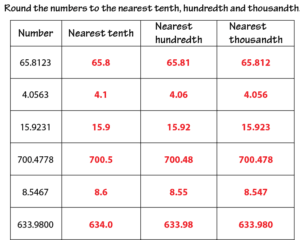
Rounding Numbers worksheets free download pdf
Round to nearest Ten, Hundred, Thousand

Round to nearest Ten, Hundred, Thousand
Round to nearest Tenth, Hundredth,Thousandth

Round to nearest Tenth, Hundredth,Thousandth
Round the numbers to underlined digit

Round the numbers to underlined digit
Furthermore, rounding is useful beyond math class. It’s a helpful life skill for estimating totals, reading charts, and making quick decisions. When students understand how and when to round numbers, they gain confidence in handling both simple and complex math problems.
With consistent practice and a few creative learning tools, rounding becomes second nature. Keep encouraging students to estimate, round, and check their answers—it’s a smart step toward better number sense and stronger math skills.

